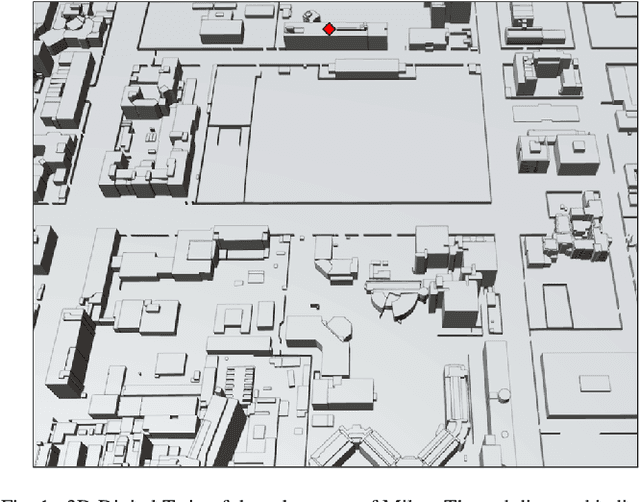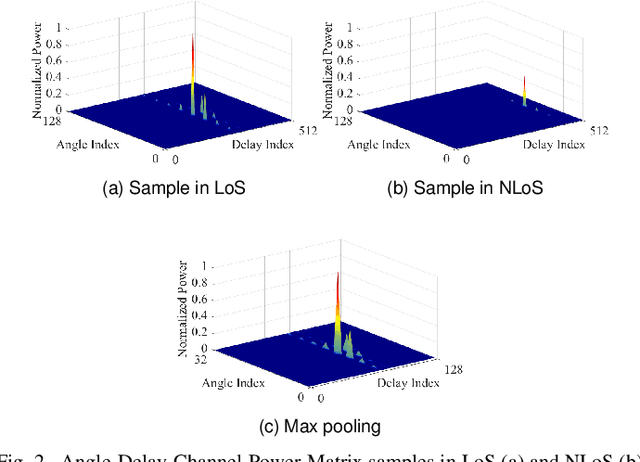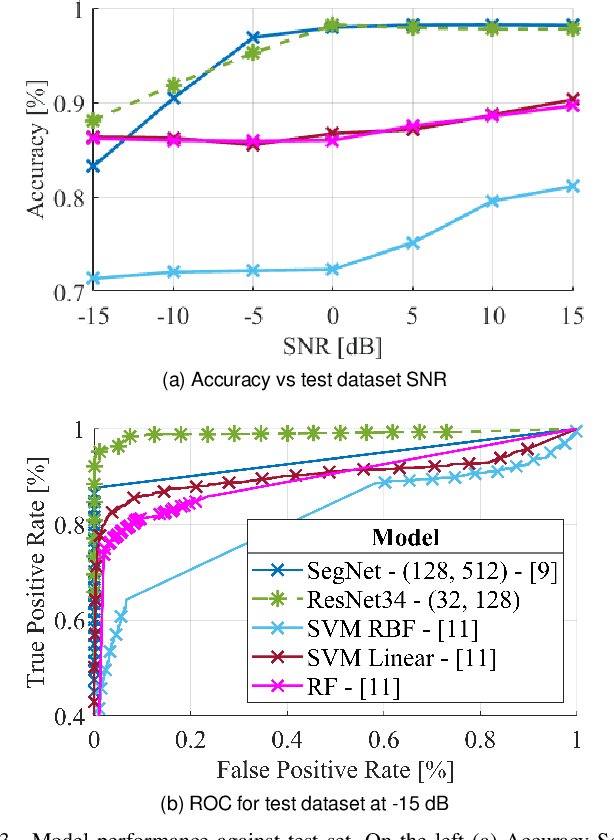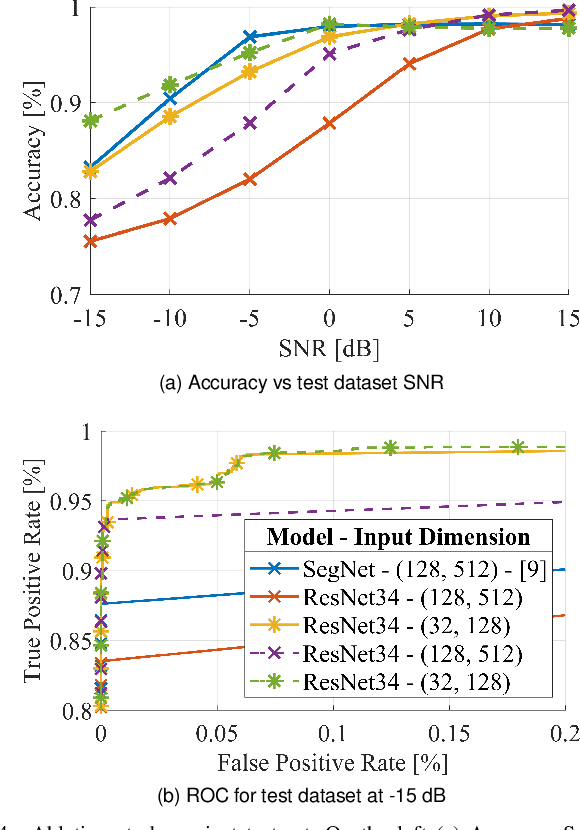Umberto Spagnolini
Enabling NLOS Imaging Capabilities at the Initial Access of 6G Base Stations
Nov 19, 2025Abstract:Sensing in non-line-of-sight (NLOS) is one of the major challenges for integrated sensing and communication systems. Existing countermeasures for NLOS either use prior knowledge on the environment to characterize all the multiple bounces or deploy anomalous reflectors in the environment to enable communication infrastructure to ''\textit{see behind the corner}''. This work addresses the integration of monostatic NLOS imaging functionalities into the initial access (IA) procedure of a next generation base station (BS), by means of a non-reconfigurable modular reflector. During standard-compliant IA, the BS sweeps a narrow beam using a pre-defined dedicated codebook to achieve the beam alignment with users. We introduce the imaging functionality by enhancing such codebook with imaging-specific entries that are jointly designed with the angular configuration of the modular reflector to enable high-resolution imaging of a region in NLOS by \textit{coherently} processing all the echoes at the BS. We derive closed-form expressions for the near-field (NF) spatial resolution, as well as for the \textit{effective aperture} (i.e., the portion of the reflector that actively contributes to improve image resolution). The problem of imaging of moving targets in NLOS is also addressed, and we propose a maximum-likelihood estimation for target's velocity in NF and related theoretical bound. Further, we discuss and quantify the inherent communication-imaging performance trade-offs and related system design challenges through numerical simulations. Finally, the proposed imaging method employing modular reflectors is validated both numerically and experimentally, showing the effectiveness of our concept.
Chartwin: a Case Study on Channel Charting-aided Localization in Dynamic Digital Network Twins
Aug 12, 2025Abstract:Wireless communication systems can significantly benefit from the availability of spatially consistent representations of the wireless channel to efficiently perform a wide range of communication tasks. Towards this purpose, channel charting has been introduced as an effective unsupervised learning technique to achieve both locally and globally consistent radio maps. In this letter, we propose Chartwin, a case study on the integration of localization-oriented channel charting with dynamic Digital Network Twins (DNTs). Numerical results showcase the significant performance of semi-supervised channel charting in constructing a spatially consistent chart of the considered extended urban environment. The considered method results in $\approx$ 4.5 m localization error for the static DNT and $\approx$ 6 m in the dynamic DNT, fostering DNT-aided channel charting and localization.
Channel Charting in Smart Radio Environments
Aug 10, 2025Abstract:This paper introduces the use of static electromagnetic skins (EMSs) to enable robust device localization via channel charting (CC) in realistic urban environments. We develop a rigorous optimization framework that leverages EMS to enhance channel dissimilarity and spatial fingerprinting, formulating EMS phase profile design as a codebook-based problem targeting the upper quantiles of key embedding metric, localization error, trustworthiness, and continuity. Through 3D ray-traced simulations of a representative city scenario, we demonstrate that optimized EMS configurations, in addition to significant improvement of the average positioning error, reduce the 90th-percentile localization error from over 60 m (no EMS) to less than 25 m, while drastically improving trustworthiness and continuity. To the best of our knowledge, this is the first work to exploit Smart Radio Environment (SRE) with static EMS for enhancing CC, achieving substantial gains in localization performance under challenging None-Line-of-Sight (NLoS) conditions.
AI-empowered Real-Time Line-of-Sight Identification via Network Digital Twins
May 21, 2025



Abstract:The identification of Line-of-Sight (LoS) conditions is critical for ensuring reliable high-frequency communication links, which are particularly vulnerable to blockages and rapid channel variations. Network Digital Twins (NDTs) and Ray-Tracing (RT) techniques can significantly automate the large-scale collection and labeling of channel data, tailored to specific wireless environments. This paper examines the quality of Artificial Intelligence (AI) models trained on data generated by Network Digital Twins. We propose and evaluate training strategies for a general-purpose Deep Learning model, demonstrating superior performance compared to the current state-of-the-art. In terms of classification accuracy, our approach outperforms the state-of-the-art Deep Learning model by 5% in very low SNR conditions and by approximately 10% in medium-to-high SNR scenarios. Additionally, the proposed strategies effectively reduce the input size to the Deep Learning model while preserving its performance. The computational cost, measured in floating-point operations per second (FLOPs) during inference, is reduced by 98.55% relative to state-of-the-art solutions, making it ideal for real-time applications.
Exploiting Age of Information in Network Digital Twins for AI-driven Real-Time Link Blockage Detection
May 21, 2025Abstract:The Line-of-Sight (LoS) identification is crucial to ensure reliable high-frequency communication links, especially those vulnerable to blockages. Network Digital Twins and Artificial Intelligence are key technologies enabling blockage detection (LoS identification) for high-frequency wireless systems, e.g., 6>GHz. In this work, we enhance Network Digital Twins by incorporating Age of Information (AoI) metrics, a quantification of status update freshness, enabling reliable real-time blockage detection (LoS identification) in dynamic wireless environments. By integrating raytracing techniques, we automate large-scale collection and labeling of channel data, specifically tailored to the evolving conditions of the environment. The introduced AoI is integrated with the loss function to prioritize more recent information to fine-tune deep learning models in case of performance degradation (model drift). The effectiveness of the proposed solution is demonstrated in realistic urban simulations, highlighting the trade-off between input resolution, computational cost, and model performance. A resolution reduction of 4x8 from an original channel sample size of (32, 1024) along the angle and subcarrier dimension results in a computational speedup of 32 times. The proposed fine-tuning successfully mitigates performance degradation while requiring only 1% of the available data samples, enabling automated and fast mitigation of model drifts.
Joint Optimization of Uplink and Downlink Power in Full-Duplex Integrated Access and Backhaul
Apr 05, 2025Abstract:We examine the performance of an Integrated Access and Backhaul (IAB) node as a range extender for beyond-5G networks, focusing on the significant challenges of effective power allocation and beamforming strategies, which are vital for maximizing users' spectral efficiency (SE). We present both max-sum SE and max-min fairness power allocation strategies, to assess their effects on system performance. The results underscore the necessity of power optimization, particularly as the number of users served by the IAB node increases, demonstrating how efficient power allocation enhances service quality in high-load scenarios. The results also show that the typical line-of-sight link between the IAB donor and the IAB node has rank one, posing a limitation on the effective SEs that the IAB node can support.
Hybrid MIMO in the Upper Mid-Band: Architectures, Processing, and Energy Efficiency
Mar 03, 2025Abstract:As 6G networks evolve, the upper mid-band spectrum (7 GHz to 24 GHz), or frequency range 3 (FR3), is emerging as a promising balance between the coverage offered by sub-6 GHz bands and the high-capacity of millimeter wave (mmWave) frequencies. This paper explores the structure of FR3 hybrid MIMO systems and proposes two architectural classes: Frequency Integrated (FI) and Frequency Partitioned (FP). FI architectures enhance spectral efficiency by exploiting multiple sub-bands parallelism, while FP architectures dynamically allocate sub-band access according to specific application requirements. Additionally, two approaches, fully digital (FD) and hybrid analog-digital (HAD), are considered, comparing shared (SRF) versus dedicated RF (DRF) chain configurations. Herein signal processing solutions are investigated, particularly for an uplink multi-user scenario with power control optimization. Results demonstrate that SRF and DRF architectures achieve comparable spectral efficiency; however, SRF structures consume nearly half the power of DRF in the considered setup. While FD architectures provide higher spectral efficiency, they do so at the cost of increased power consumption compared to HAD. Additionally, FI architectures show slightly greater power consumption compared to FP; however, they provide a significant benefit in spectral efficiency (over 4 x), emphasizing an important trade-off in FR3 engineering.
Optimal Planning for Heterogeneous Smart Radio Environments
Nov 23, 2024Abstract:Smart Radio Environment (SRE) is a central paradigms in 6G and beyond, where integrating SRE components into the network planning process enables optimized performance for high-frequency Radio Access Network (RAN). This paper presents a comprehensive planning framework utilizing realistic urban scenarios and precise channel models to analyze diverse SRE components, including Reconfigurable Intelligent Surface (RIS), Network-Controlled Repeater (NCR), and advanced technologies like Simultaneous transmitting and reflecting RIS (STAR RIS) and trisectoral NCR (3SNCR). We propose two optimization methods, full coverage minimum cost (FCMC) and maximum budget-constrained coverage (MBCC), that address key cost and coverage objectives by considering both physical characteristics and scalable costs of each component, influenced by factors such as NCR amplification gain and RIS dimensions. Extensive numerical results demonstrate the significant impact of these models in enhancing network planning efficiency for high-density urban environments.
Advanced Network Planning in 6G Smart Radio Environments
Nov 09, 2024



Abstract:The growing demand for high-speed, reliable wireless connectivity in 6G networks necessitates innovative approaches to overcome the limitations of traditional Radio Access Network (RAN). Reconfigurable Intelligent Surface (RIS) and Network-Controlled Repeater (NCR) have emerged as promising technologies to address coverage challenges in high-frequency millimeter wave (mmW) bands by enhancing signal reach in environments susceptible to blockage and severe propagation losses. In this paper, we propose an optimized deployment framework aimed at minimizing infrastructure costs while ensuring full area coverage using only RIS and NCR. We formulate a cost-minimization optimization problem that integrates the deployment and configuration of these devices to achieve seamless coverage, particularly in dense urban scenarios. Simulation results confirm that this framework significantly reduces the network planning costs while guaranteeing full coverage, demonstrating RIS and NCR's viability as cost-effective solutions for next-generation network infrastructure.
Multi-View Integrated Imaging and Communication
Oct 03, 2024



Abstract:Non-line-of-sight (NLOS) operation is one of the open issues to be solved for integrated sensing and communication (ISAC) systems to become a pillar of the future wireless infrastructure above 10 GHz. Existing NLOS countermeasures use either metallic mirrors, that are limited in coverage, or reconfigurable metasurfaces, that are limited in size due to cost. This paper focuses on integrated imaging and communication (IIAC) systems for NLOS exploration, where a base station (BS) serves the users while gathering a high-resolution image of the area. We exploit a large reflection plane, that is phase-configured in space and time jointly with a proper BS beam sweeping to provide a multi-view observation of the area and maximizing the image resolution. Remarkably, we achieve a near-field imaging through successive far-field acquisitions, limiting the design complexity and cost. Numerical results prove the benefits of our proposal.
 Add to Chrome
Add to Chrome Add to Firefox
Add to Firefox Add to Edge
Add to Edge